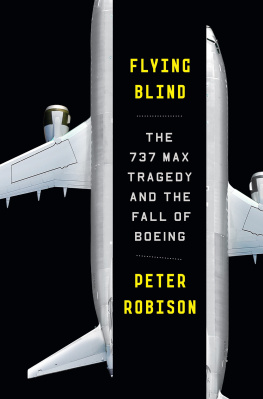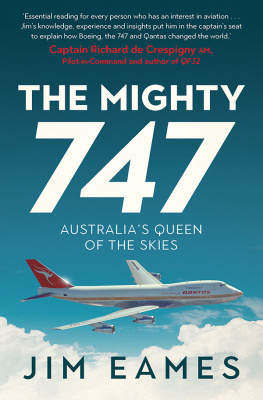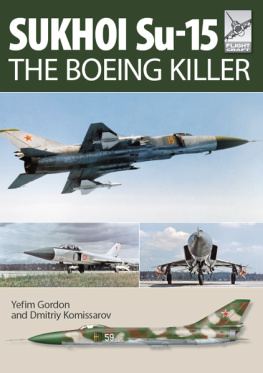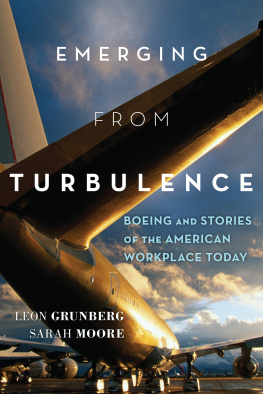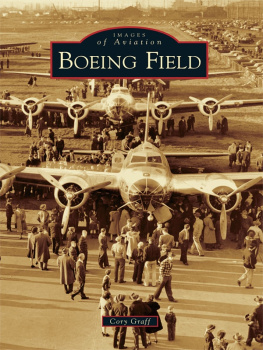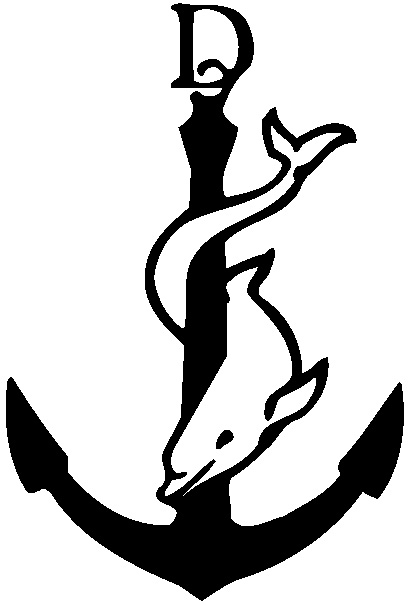All rights reserved. Published in the United States by Doubleday, a division of Penguin Random House LLC, New York, and distributed in Canada by Penguin Random House Canada Limited, Toronto.
doubleday and the portrayal of an anchor with a dolphin are registered trademarks of Penguin Random House LLC.
Names: Robison, Peter, author.
Title: Flying blind : the 737 MAX tragedy and the fall of Boeing / Peter Robison.
Description: First edition. | New York : Doubleday, [2021] | Includes bibliographical references and index.
Identifiers: LCCN 2021006584 (print) | LCCN 2021006585 (ebook) | ISBN 9780385546492 (hardcover) | ISBN 9780593082515 (trade paperback) | ISBN 9780385546508 (ebook)
Subjects: LCSH: Boeing CompanyManagement. | Boeing 737 (Jet transport)Accidents. | Aircraft industryUnited StatesManagement. | Aircraft industryUnited StatesEmployees. | Corporate culture.
Classification: LCC HD9711.U63 B6363 2021 (print) | LCC HD9711.U63 (ebook) | DDC 338.7/6291300973dc23
INTRODUCTION
The scene before dawn at Soekarno-Hatta International Airport in Jakarta on October 29, 2018, was like that at any other big airport in the age of routinized international travel. In the concourses, bleary-eyed families and solo travelers clumped outside gates or gulped a hurried breakfast from Dunkin Donuts or Burger King, the latter of which, in this majority Muslim country, offered a Halal-certified rice and crispy chicken combo (the King Deal). Others window-shopped for Kiehls face cream or electronic gadgets. As the sun rose it was finally light enough to see the tropical gardens of narra trees, palms, and orchids outsideone of the few clues the traveler wasnt in Kansas City or Stuttgart.
Not many gave a thought to the machines parked beside the jetways, many of them Boeing 737s, the stub-nosed workhorses of airline fleets since the 1970s. Commercial aircraft are considered the worlds premier expression of manufacturing excellence, designed by tens of thousands of people around the world who put their hands on themat first figuratively, on the computer screens of engineers, and then literally when machinists climb underneath them to hand-crank stubborn rivets to the desired torque. Before the planes leave Boeings factory near Seattle, airlines send their own representatives to inspect every inch and reject the machines if they find, say, a loose bin or a fray in the forty miles of wiring (or, as sometimes happens, a forgotten wrench or gum wrapper).
The people gathered around Gate B5 that morning for Lion Air Flight 610 were about to board the newest and most advanced of more than ten thousand 737s Boeing had manufactured. It was called the 737 MAX 8. A far cry from the original 737, which had two tiny cigar-shaped engines tucked under its wings, this one had two massive turbofans. Almost six feet in diameter, they were so big they had to be mounted in front of the wings instead of beneath them, and the average person could stand inside the cowlings. The engines generated twenty-eight thousand pounds of thrustdouble that of the first 737 modelswhile drastically lowering fuel consumption. The new jetliner was economical enough that Lion Air could charge sixty dollars for the one-hour flight from Jakarta to Pangkal Pinang, a city of three hundred thousand on Indonesias Bangka Island.
A Lion Air subsidiary, in fact, had been the first to fly the 737 MAX, which was particularly popular with Asian airlines springing up to transport the continents millions of newly mobile middle-class travelers. One of them, Paul Ayorbaba, forty-three, sent his family a choppy WhatsApp video of his mundane walk through the jetway and out to the plane, painted a cheery orange and white. In the minutes before the doors closed, twenty-two-year-old Deryl Fida Febrianto, a newlywed of two weeks, texted a selfie to his bride as he departed for a job on a cruise ship. Wahyu Aldilla sat with his son, Xherdan Fahrezi, after visiting Jakarta for a soccer match. A grieving familyMichelle Vergina Bongkal, twenty-one, her father, Adonia, and brother Mathew, thirteenwas heading to Bangka Island for the funeral of Michelles grandmother. Twenty employees of the countrys finance ministry, returning from a weekend in Jakarta, had caught the early-morning flight to reach the office in time.
Taking the MAX through a preflight checklist, the pilot, Bhavye Suneja, typified a new generation of pilots across Asia. At thirty-one, he had already flown six thousand hours, almost all of them on previous versions of the 737. His copilot, who went by the single name Harvino, was a decade older and had about five thousand hours. Neither knew that a tiny sensor on the left side of the plane, just below Sunejas window, had a twenty-one-degree misalignment in its delicate innardsan oversight by mechanics who had inspected it. The device, known as an angle-of-attack sensor, was basically a weather vane. It measured the angle of the wing against the oncoming airtoo high, and the plane might stall. In the triple-redundant engineering of a product now more than a century old, dating to a pair of bicycle makers who hitched a 12-horsepower engine and a chain sprocket to a spruce wood frame, it wasnt even considered a particularly relevant indicator on most airplanes. Other dials measured the all-important airspeed, altitude, and pitch.
It was 6:20 a.m. when Lion Air 610 departed the runway. The nose gear had barely left the ground when Sunejas control column began shaking, the cue for a potential stall. Two alerts signaling bad altitude and airspeed readings blinked on. Flight data recorders dont pick up the expressions on pilots faces, or the stab in their spines, when they sense their docile machine might kill them. Harvino, the copilot, immediately asked the captain if he planned to turn around. Suneja suggested they get clearance to a holding point to buy some time. Flight control problem, Harvino radioed. As Suneja steered toward the new heading, the nose mysteriously dipped. He squeezed a switch on the control column under his thumb to push it back up. The nose lifted, but then it dipped again. For eight minutes, the tug-of-war continued. The blue expanse of Jakarta Bay filled the windows.
Harvino flipped through Boeings Quick Reference Handbook, searching through pages of emergency checklists for an answer. Air Speed Unreliable. Duct Bleed. Pack Trip Off. Wing-Body Overheat. Nothing seemed to explain the ghost fighting them for control of the plane. Twenty-one times Suneja pressed the switch to keep the nose pointing up. The plane was cleared for twenty-seven thousand feet but had reached less than six thousand, the fishing boats in the sea below like toys in a tub. The passengers felt every sickening undulation in their stomachs. Suneja finally got on the phone to ask a flight attendant to come into the cockpit. Yes, sir, she answered, replacing the phone with a ca-chunk (audible on the cockpit voice recorder) and opening the door. He asked her to send in a Lion Air engineer who happened to be aboard to help them figure out the problem. The chimes of the intercom sounded as she called him forward.

